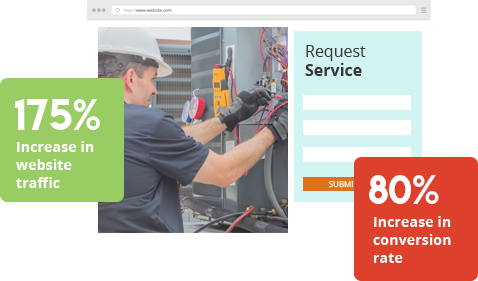Digital Content For All
The internet is an ever-expanding marketplace for big brands and small businesses alike. Not only is it important to have your products, services, and/or information available for potential customers on their devices, your business must also make digital assets and content accessible for segments of your audience that live with disabilities or impairments.
In an effort to help websites and digital platforms become more disabled-friendly, the Americans with Disabilities Act (ADA) has created specific guidelines for businesses to follow. Accommodating disabled web users is just and also expands your business’ reach. Nearly 60 million Americans (1 in 4) live with a disability or some type of impairment that interferes with the following attributes needed to fully access and navigate a website:
- Hearing / Auditory
- Vision
- Mobility
- Cognition
Many diabled persons already depend on assistive devices and software such as voice and text readers to access information and make purchases digitally. ADA compliance aims to enhance the usability of websites with or without these tools.
Is your business’ website ADA compliant? GoMarketing has got you covered! Keep reading to learn more about how to adjust your website to ensure that it is accessible to users with disabilities and impairments.
To learn more about ADA compliance and our ADACS service and software for your business, click here!

ADA Compliance + Accessibility Checklist
As a business, your digital platforms and assets are valuable. Although ADA compliance can sound tricky (and expensive), here is a checklist to help guide you along the process!
- Is your website’s content, tools, and navigation disabled-friendly with or without assistive tools?
- Does assistive technology and software like text readers interpret and translate your site’s content to disabled users accurately?
- Does your site support keyboard navigation? This simply means that a disabled user with limited or no access to a mouse or touch screen can fully access all of your platform’s features using just the keyboard.
- Can your business’ website be navigated easily and intuitively without a mouse and with assistive devices and software?
- Is your website’s design and layout consistent, intuitive, and user-friendly throughout to prevent any potential confusion?
- Is the contrast ratio between the text and page background on your web pages acceptable?
- Can the text on your website be scaled without throwing off or distorting your pages?
- Does your website implement plug-ins, video content, or design elements that may not be accessible to users with certain impairments?
Tools For Digital Success
When auditing your business’ website to ensure that it is ADA compliant, a sound approach is to try anticipating how a user with specific impairments might need to adjust the elements on any of your web pages to fully understand and access its features. Evaluating an existing, live website for accessibility will require a lot of up-front labor and involve QA testing. However, here are a few tools to help jumpstart your ADA compliance website audit–straight from our marketing specialists:
- Use Lighthouse to perform a page audit that will pinpoint any accessibility and performance issues.
- Determine comprehensive website accessibility using WAVE.
- Download a tool that will help you and your team measure contrast ratio!

GoMarketing team has compiled all of the necessary tools and resources to help businesses”
ADA Website Compliance Services
Hacks For Making Your Website Disabled-Friendly
At first, ADA compliance may seem overwhelming. However, the GoMarketing team has compiled all of the necessary tools and resources to help businesses like you secure long-term accessibility for disabled users. The following hacks and practices will optimize all of your current and future web content, so it’s disabled-friendly and accessible to all.
» Well-Curated Images + Graphics
Viral memes and infographics are all the rage when it comes to digital content. Although these elements are visually entertaining and informational, they are not always accessible to people with disabilities and/or impairments. That’s why we advise all of our business clients to keep it simple when it comes to their web content by avoiding flashing images and/or complicated plug-ins. Also, for any embedded images and videos, be sure to attach clear text captions for users that need text reading software.
Alt-text captions for images are also important. This element not only bolsters your website’s SEO, it also allows for text reading software to describe image content to visually impaired users.
» Easy-To-Read Fonts
In most cases, font choice is implemented based on a matter of aesthetic styles and brand designs. Although the wrong font style and size will lead to headaches and/or eye strain for the average web user, font choice is a major factor that contributes to whether or not a visually impaired user can read or access your website’s information at all. In order to accommodate this segment of web users, opt for a light background on web pages and choose a simple font in a dark color to prevent strain for users with sensitive eyes. Here are some of the best readable and accessible fonts for ADA compliant websites:
- Georgia
- Open Sans
- Quicksand
- Arial
- Franklin Gothic
- Helvetica
- Verdana
Clear Call-To-Action + Instructions
Let’s face it: pop-up ads and windows are frustrating. Even for the average user, these elements can seem impossible to close or avoid. Similarly, it’s important to consider digital forms or call-to-action buttons that aren’t clear or lead the user through too many hoops. These issues are more than just an annoyance for disabled people trying to access your website. They can make can your business’ content and information nearly impossible to navigate, creating a lose-lose situation for both you and the potential customer. Prioritize creating simple and intuitive navigation and instructions for all of your website’s features and tools. This involves clearly identifying page elements, breaking up large blocks of text, and making it easier than ever for users to move among web pages just using their keyboard.
HTML Tags
Did you know that many text readers that translate written page content to audio can’t understand or translate complicated code and image files? That’s why it’s important to ensure that your website uses HTML tags, which makes all of your digitally embedded files tex-based. This allows anyone with a disability or impairment to access your business’ information with readable and translatable web content. Keep in mind that If your website runs via a CMS such as WordPress, all of your content is automatically text-based, so you have one less thing to worry about.

Keyboard Navigation Is Key
Savvy UX design should focus on easy navigation and clear layouts for any and all users. Keep in mind that if your business’ website offers auto-play video content or slide through presentations, you will need to accommodate disabled or impaired users that rely on keyboard navigation to pause and/or slow down these kinds of digital content by means of downloadable tools and features.
Good Practices Mean Better Business
Building an accessible, ADA compliant website isn’t just about following legal policies. It’s about doing the right thing. ADA compliance is also a no-brainer from a business perspective. Making sure your website is disabled-friendly only broadens your brand’s reach by providing access to anyone and everyone who otherwise couldn’t–from visually impaired customers to home-bound seniors. As the 21st century continues to unfold, digital access is crucial for everyday life, including interpersonal communications, shopping, and paying bills.
ADA Compliant + Accessible Websites For Los Angeles + Ventura County
Are you a local business in Los Angeles or Ventura County in need of an ADA compliant website? At GoMarketing, we’ve specialized in developing and redesigning websites for clients since 2002, and we have the tools you need to ensure that your website is disabled-friendly over the long-term. We’ve provided digital marketing assets and solutions throughout Southern California, including:
- Agoura Hills
- Bell Canyon
- Calabasas
- Camarillo
- Carpinteria
- Los Angeles
- Chatsworth
- Dos Vientos
- Fillmore
- Goleta
- Lake Sherwood
- Malibu
- Moorpark
- Newbury Park
- Northridge
- Oak Park
- Oak View
- Ojai
- Oxnard
- Port Hueneme
- Santa Barbara
- Santa Clarita
- Santa Paula
- Simi Valley
- Thousand Oaks
- Ventura
- Westlake Village
- Woodland Hills
ADA Compliance FAQ
Do you have a question about ADA compliance or any of the related terms in this article? Check out our handy FAQ!
What is the American Disabilities Act (ADA)?
The Americans with Disabilities Act (ADA), is a 1990 Civil Rights Law that prohibits discrimination against persons with disabilities in many areas of public life. Title III of the Act pertains to accessibility for all to services offered by private entities.
Title III of the ADA has recently been interpreted as pertaining to website accessibility for visitors with vision, hearing, and speech impairments.
What is WCAG 2.1?
ADA Title III has no detailed compliance goals for website owners to follow. So, the court system has looked to WCAG 2.1, Web Content Accessibility Guidelines (WCAG) 2.1 as the guide for ADA compliance.
If your business is sued, it will be according to the guidelines stated in WCAG 2.1.
What is Section 508?
Section 508 is a separate compliance law that covers government and government contractors’ websites exclusively and comes with its own set of guidelines.
What is QA testing?
QA testing involves activities that ensure the implementation of processes, procedures, and standards in context to verification of developed software and intended requirements.
What is ADACS software and how does it work?
ADACS software is a visitor adjustable front end and back end layer system. In fact, 90% of all ADA issues are covered by ADACS and can be implemented by users with disabilities. With it, disabled or impaired users gain the opportunity to alter your website interface for their own unique experience, fitting their specific needs and requirements.
What does Lighthouse software do?
Lighthouse is an open-source, automated tool for improving the quality of web pages. You can run it against any web page, public or requiring authentication. It has audits for performance, accessibility, progressive web apps, and more–making ADA compliance a virtual breeze.
What are some good contrast ratio tools for my business’ website and digital content?
There are a bevy of apps and programs that can help your web team get contrast ratio just right. Here are just a few of them:
- Contrast
- Color Safe
- Tanaguru Contrast-Finder
- Stark
- Spectrum
Have a question but don’t see it listed above? Contact us with any direct inquiries here! For more information on how to keep growing your business online with our digital solutions, call GoMarketing at 805.413.7893.





